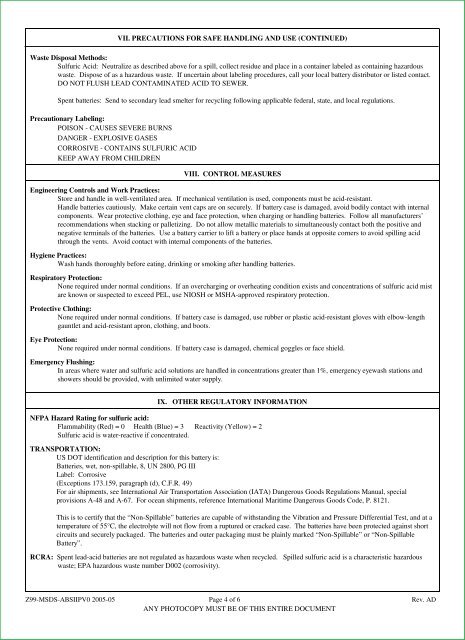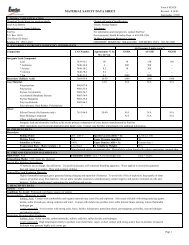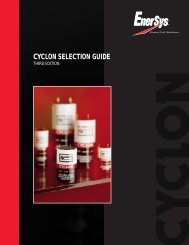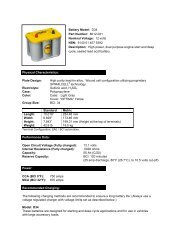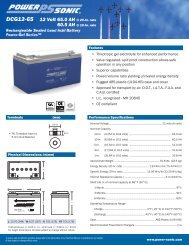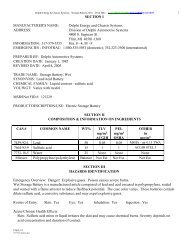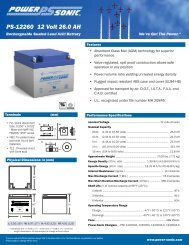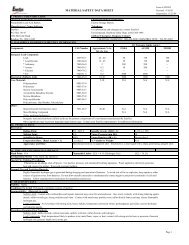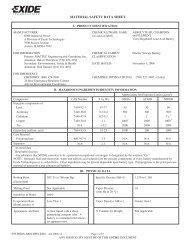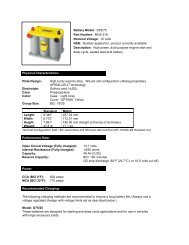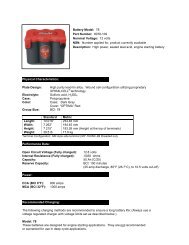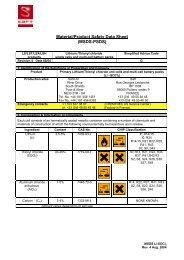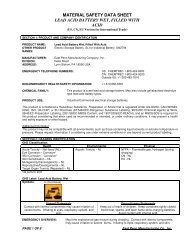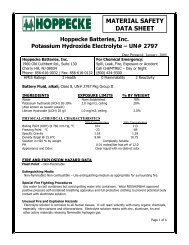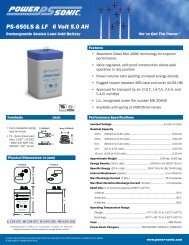Exide Absolyte IIP V0 MSDS - Battery Web
Exide Absolyte IIP V0 MSDS - Battery Web
Exide Absolyte IIP V0 MSDS - Battery Web
Create successful ePaper yourself
Turn your PDF publications into a flip-book with our unique Google optimized e-Paper software.
VII. PRECAUTIONS FOR SAFE HANDLING AND USE (CONTINUED)<br />
Waste Disposal Methods:<br />
Sulfuric Acid: Neutralize as described above for a spill, collect residue and place in a container labeled as containing hazardous<br />
waste. Dispose of as a hazardous waste. If uncertain about labeling procedures, call your local battery distributor or listed contact.<br />
DO NOT FLUSH LEAD CONTAMINATED ACID TO SEWER.<br />
Spent batteries: Send to secondary lead smelter for recycling following applicable federal, state, and local regulations.<br />
Precautionary Labeling:<br />
POISON - CAUSES SEVERE BURNS<br />
DANGER - EXPLOSIVE GASES<br />
CORROSIVE - CONTAINS SULFURIC ACID<br />
KEEP AWAY FROM CHILDREN<br />
VIII. CONTROL MEASURES<br />
Engineering Controls and Work Practices:<br />
Store and handle in well-ventilated area. If mechanical ventilation is used, components must be acid-resistant.<br />
Handle batteries cautiously. Make certain vent caps are on securely. If battery case is damaged, avoid bodily contact with internal<br />
components. Wear protective clothing, eye and face protection, when charging or handling batteries. Follow all manufacturers’<br />
recommendations when stacking or palletizing. Do not allow metallic materials to simultaneously contact both the positive and<br />
negative terminals of the batteries. Use a battery carrier to lift a battery or place hands at opposite corners to avoid spilling acid<br />
through the vents. Avoid contact with internal components of the batteries.<br />
Hygiene Practices:<br />
Wash hands thoroughly before eating, drinking or smoking after handling batteries.<br />
Respiratory Protection:<br />
None required under normal conditions. If an overcharging or overheating condition exists and concentrations of sulfuric acid mist<br />
are known or suspected to exceed PEL, use NIOSH or MSHA-approved respiratory protection.<br />
Protective Clothing:<br />
None required under normal conditions. If battery case is damaged, use rubber or plastic acid-resistant gloves with elbow-length<br />
gauntlet and acid-resistant apron, clothing, and boots.<br />
Eye Protection:<br />
None required under normal conditions. If battery case is damaged, chemical goggles or face shield.<br />
Emergency Flushing:<br />
In areas where water and sulfuric acid solutions are handled in concentrations greater than 1%, emergency eyewash stations and<br />
showers should be provided, with unlimited water supply.<br />
IX. OTHER REGULATORY INFORMATION<br />
NFPA Hazard Rating for sulfuric acid:<br />
Flammability (Red) = 0 Health (Blue) = 3 Reactivity (Yellow) = 2<br />
Sulfuric acid is water-reactive if concentrated.<br />
TRANSPORTATION:<br />
US DOT identification and description for this battery is:<br />
Batteries, wet, non-spillable, 8, UN 2800, PG III<br />
Label: Corrosive<br />
(Exceptions 173.159, paragraph (d), C.F.R. 49)<br />
For air shipments, see International Air Transportation Association (IATA) Dangerous Goods Regulations Manual, special<br />
provisions A-48 and A-67. For ocean shipments, reference International Maritime Dangerous Goods Code, P. 8121.<br />
This is to certify that the “Non-Spillable” batteries are capable of withstanding the Vibration and Pressure Differential Test, and at a<br />
temperature of 55°C, the electrolyte will not flow from a ruptured or cracked case. The batteries have been protected against short<br />
circuits and securely packaged. The batteries and outer packaging must be plainly marked “Non-Spillable” or “Non-Spillable<br />
<strong>Battery</strong>”.<br />
RCRA: Spent lead-acid batteries are not regulated as hazardous waste when recycled. Spilled sulfuric acid is a characteristic hazardous<br />
waste; EPA hazardous waste number D002 (corrosivity).<br />
Z99-<strong>MSDS</strong>-ABS<strong>IIP</strong><strong>V0</strong> 2005-05 Page 4 of 6 Rev. AD<br />
ANY PHOTOCOPY MUST BE OF THIS ENTIRE DOCUMENT


